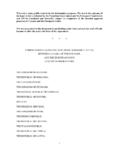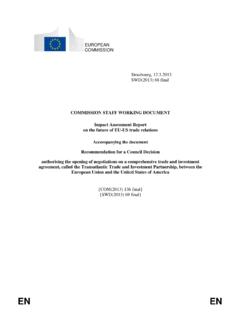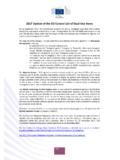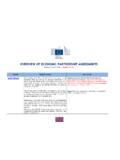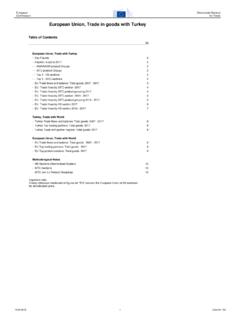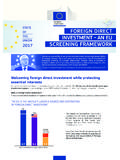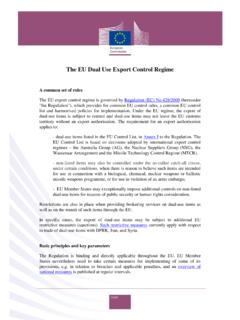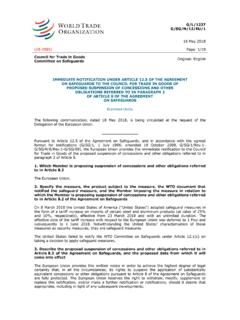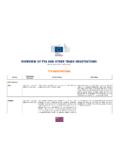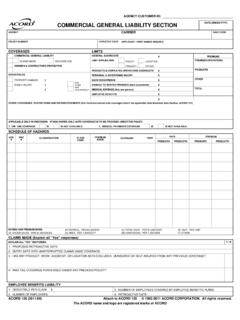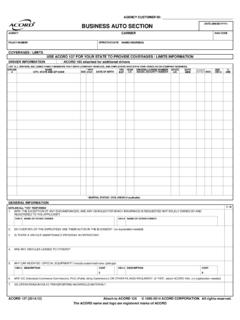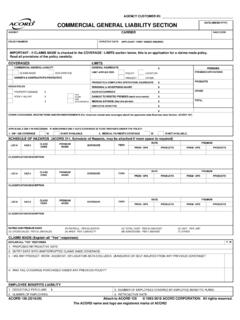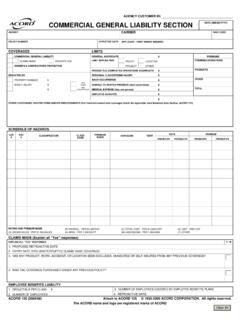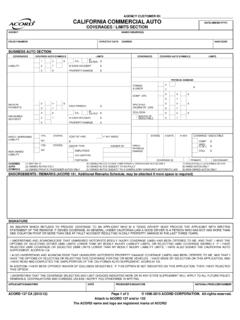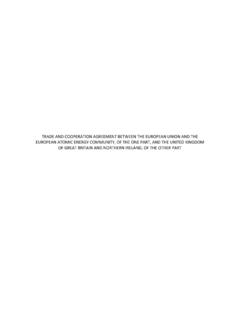Transcription of THE EU-UK trade agreement explained - slide show
1 European Commission DG TradeTHE EU-UKTRADE agreement EXPLAINEDCONTENTS1. What is the EU-UK trade agreement ?2. EU-UK trade and Investment relations3. What does the trade part of the agreement with the UK mean?4. The agreement chapter by chapter5. Next steps towards implementation21. WHAT IS THE EU-UK trade agreement ?323/06/2016 The UK votes to leave the EU in referendum29/03/2017 The UK formallynotifies its intention to leave the EU (Article 50)29/04/2017 European Council adopts principles and guidelines for the negotiations19/06/2017 Launch of formal negotiations onthe UK swithdrawal23/03/2018 European Council adopts guidelines on the framework for a future relationship with the UK after Brexit17/10/2019EU and UK negotiators reach agreement on a revised Withdrawal agreement & Political DeclarationSummer-Autumn 2019 Renegotiation of the Protocol on Ireland and Northern Ireland (under Prime Minister Boris Johnson)25/11/2018EU27 leaders endorse Withdrawal agreement ,including Protocol on Ireland and Northern Ireland, and approve the Political Declaration08/12/2017EU27 leaders agree sufficient progress made in withdrawal negotiations.
2 Agree to open talks on framework for future relationship14/11/2018EU and UK negotiators (under Prime Minister Theresa May) reach agreement on the Withdrawal agreement &ona Political Declaration on future relationship17/10/2019EU27 leaders endorse revised Withdrawal agreement and approve Political Declaration30/01/2020 Ratification of Withdrawal agreement is complete02/03/2020 Launch of formal negotiations on a future EU-UK Partnership Agreement25/02/2020 Council adopts a mandate for the negotiation on the future EU-UK partnershipEU-UK RELATIONS: From the UK referendum to a new Partnership Agreement24/12/2020EU & UK negotiators agree on draft Partnership Agreement01/02/2020 The UK leaves the EU; start of transition period during which EU rights and obligations still apply to the UK01/01/2021 Transition period ends. Provisional ratified, new EU-UK Partnership agreement enters into force5 THE STEPS TO A NEW RELATIONSHIPU ntil 31 January 20201 Feb 2020 to 31 Dec 20201 January 2021EU MembershipTransition period and Withdrawal AgreementNewEU-UKAgreement,WithdrawalAgr eement(citizens rights,protectionofGI)andNorthernIreland ProtocolEU-UK RELATIONS.
3 Architecture of the new PartnershipAgreementTrade, economic, social & environmentalpartnershipInternal security partnership for citizens safetyNew EU-UK governance framework for a lasting partnership Free, fair& sustainabletrade trade in goods Customs & regulatory cooperation trade in services& investment Public procurement Rules for fair competition & sustainability Intellectual Property RightsConnectivity, sustainability & shared opportunities Transport Energy and climate Fisheries & natural resources Social security coordination Union programmes Law enforcement & judicial cooperation in criminal matters Protection of fundamental rights Data exchange Anti-money laundering Partnership Council Dispute settlement, enforcement & sanctions mechanisms Periodic reviewsPartnership agreement for Cooperation and TradeEU unilateral measuresNot covered by the negotiations: Equivalences in financial services Adequacy decision on data protection UK third-country SPS listingWHY IS THIS agreement DIFFERENT FROM OTHER AGREEMENTS COVERING trade ?
4 ,ratherthanseekingconvergence. Theagreementcoversawiderangeofareas,from fisheriestojusticeandhomeaffairs,thatgof arbeyondusualFreeTradeAgreements. EU-UK trade AND INVESTMENT RELATIONS8EU27 UKPopulation (Q3 2020) millionGDP (2019)13 964 billion 2 523 billion trade in goods(2019)1st worldtrader5th world trader (afterEU, China, US and Japan)Imports1 940 billion of which 194 billion from UK (10%, 3rdsupplier)620 billion of which 49% from EU (1stsupplier)Exports2 132 billion of which 319 billion to UK (15%, 2ndclient)420 billion of which 46% to EU (1stclient)Total trade4 072 billion of which 514 billion with UK (13%, 3rdpartner)1 040 billion of which 48% with EU (1stpartner)EU 27 AND UK IN COMPARISONThe EU represents almost 50% of UK trade EU first trading partner for the UK (48,1%). UK third trading partner for the EU after the US and China (12,6%). 10 Goods/2019 ImportsExportsTotal tradeImportsExportsTotal tradeUK in EU trade10,0%15,0%12,6%323EU in UK trade49,4%46,1%48,1%111 ShareRankingEU s positive balance in trade in goods stable11 Machinery, cars and chemicals are the main exports in both directionsMAIN EU EXPORTS OF GOODSM achineryandappliances(20%)Transportequip ment(20%)Chemicalproducts(13%)Foodstuff, beverages,tobacco(7%)Basemetals(5%)Plast ics,rubber(5%)12 MAIN UK EXPORTS OF GOODSM achineryandappliances(21%)Chemicalproduc ts(15%)Transportequipment(14%)Mineralpro ducts(12%)Basemetals(6%)Foodstuffs,bever ages,tobacco(5%) trade in Services: balance in favour of the EU, with a slight increase since 2016 13EU exports to UK.
5 Business, professional and tourism services14 Business and professional services25%Tourism services19%Telecommunications and IT services14%Financial services13%Transport12%Charges for the IP use5%Insurance and pension services3%Manufacturing services 2%Personal, cultural, and recreational services2%Construction2%Maintenance and repair services 1%Other2%EU EXPORTS IN SERVICES TO UK BY SECTOR (2019)UK exports to EU:Business, professional and financial services15 Business and professional services36%Financial services13%Tourism services12%Telecommunications & IT services10%Transport9%Charges for the IP use8%Insurance and pension services4%Personal, cultural, and recreational services3%Maintenance and repair services2%Construction1%Other 2%EU IMPORTS IN SERVICES FROM UK BY SECTOR (2019)Total stock of mutual investments remain among the highest in the world16EU investment flows in the UK in steady decline since UK flows to EU 27 have increased in 2017 and The trade PART of the agreement with the UK 18 THE agreement DOES NOT REPLICATE EU MEMBERSHIP Nofrictionlesstrade Potentiallydifferentrulesforindustrialpr oducts Nopossibilitytocertifyproductsforexportt otheexportingcountry Noobligationtoreducelevelsofborderchecks asregardsSPSrequirements Nopassportingrightsforfinancialservices Noautomaticrecognitionofprofessionalqual ifications Hostcountryprincipleapplies(asopposedtoS ingleMarket shomecountryrule)BUT19 DELIVERS THE CHALLENGE OF SECURING HIGH QUALITY MARKET ACCESS WITH 2 CRITICAL CONDITIONSA high quality market access while.
6 Not compromising the autonomy and integrity of the internal market and Securing a clear and enforceable level playing field20 THE agreement SECURES HIGH QUALITY MARKET ACCESS Zerotariffsandzeroquotas Highqualitymarketaccessonservicesandinve stmentbeyondthelevelachievedwithJapan Unprecedentedresultsonpublicprocurement2 1 PROVIDES THE COMPLEMENT TO MARKET ACCESS WHILE PRESERVING THE AUTONOMY AND INTEGRITY OF THE EU INTERNAL MARKET Aframeworkforcooperationonregulatoryaffa irsinkeysectors( ) ModernrulesoforiginbasedontheEUplatform Self-declarationofconformityforlargeprod ucers22 AND GUARANTEING A LEVEL PLAYING FIELD Soliddisciplinesforstateaidcontrol,compe tition,state-ownedenterprises Non-regressionfromlabourandsocial,enviro nmentandclimate,taxationlevelsofprotecti on Rulesontradeandsustainability Robustenforcementtools(domesticenforceme nt,disputesettlement,unilateraltools) Managementofdivergenceonrulesovertime234 .
7 THE agreement CHAPTER BY CHAPTER24 THE STRUCTURE OF THE ECONOMIC I: trade in II: trade in Services and III: Digital IV: Capital movements and V: Intellectual VI: Public VII: Small and medium-sized VIII: Energy EU: and raw IX: X: Good regulatory practices and regulatory XI: Level playing field for open and fair competition and sustainable XII: Exceptions25 MAIN PURPOSE: Reciprocaldutyandquotafreetradebetweenth eEUandtheUK EstablishingWTOplusdisciplinesinbilatera ltradeKEY ELEMENTS: Allcustomsdutiesonbilateralimportsforgoo dsoriginatingintheEUandUKareprohibited Exportdutiesareequallyprohibited Nocustomsfees&charges,exceptforspecifics ervicesrendered,andproportionatetothecos toftheservice26I: MARKET ACCESS & National Treatment(1) GoingbeyondWTOrulesonavoidingrestriction sintradebetweentheEUandtheUK: Prohibitionofimport&exportmonopoliesandi mport&exportrestrictions,includingnopric erequirementsonimportsandexportsandnoper formancerequirementsinlicensing.
8 Importandexportlicensingprocedures:addin gWTOplusprovisionslimitingtheuseofnon-au tomaticimportlicensesandonestablishingru lesonexportlicensingprocedures Customsfees:asarulefree,exceptifspecific servicesarerendered:forsuchcasestranspar entandproportionaltoactualcostofservice, notvalueofthegood. IncorporationofGATT provisionsonnationaltreatment,freedomoft ransit. : MARKET ACCESS & National Treatment(2)SectorEU Exports to UK in billion , 2019EU exports to UK as % total EU sectorexports EU Exports liberalisedin FTAT ariffs incase of no to 8% to to & to 12% : MARKET ACCESS (3): IndustrialgoodsWhat Duty-free Quota-free means for some key sectors29I: MARKET ACCESS (4): AgricultureWhat Duty-free Quota-free means for some key sectorsSectorEU exports to UK inbillion , 2019 EUexports to UK as % of total EU sector exportsEU exports to UK as % of EU productionTariffs incase of no ~45% ~40% ~30% to 50% food (exceptbeverages) ELEMENTS (cultural objects).
9 Cooperationinfacilitatingthereturnofcult uralpropertyillicitlyremovedfromtheterri toryofaParty,inlinewiththeprinciplesensh rinedintheUNESCOC onvention RemovedfromterritoryofaPartyonorafter1 January1993 CooperationshallinvolvetheCustomsauthori tiesoftheParties,andcreationofacontactpo int30 PURPOSES: Facilitatethereturnofculturalpropertyill icitlyremovedfromaterritoryofaParty Protecttaxpayers moneyfromcustomsfraudandadministrativeer rorsI: CULTURAL OBJECTS &ANTIFRAUDKEY ELEMENTS (antifraud): Enhancedcooperationmechanismsfordetectin gandcombatingbreachesorcircumventionsofc ustomslegislation Temporarysuspensionofpreferencesforagive nproductincaseofsystematicandlargescaleb reachesKEY ELEMENTS: ConfirmtheavailabilityofWTOtradedefencei nstruments(anti-dumping,anti-subsidy,saf eguard) ConfirmtheavailabilityofWTOagriculturals afeguardmechanism Includerulesontransparencyandbestpractic e31 PURPOSE: Addressunfairtradepractices(dumping,subs idies)orasuddensurgeinoverallimportsI: trade REMEDIES32 PURPOSE: Establish origin criteria for preferential market access Only goods originating in the EU and the UK can benefit from tariff preferencesKEY ELEMENTS: Rules corresponding to the EU platform for preferential Rules of Origin Modern and business friendly general rules, allowing fullbilateral cumulation, No cumulation with any third countries.
10 trade facilitating product-specific rules in line with the most modern EU platform for rules of originin FTAs, with some adaptation to reflect technological developments. Modern procedures for claim of preferences and verificationI: RULES OF ORIGIN (1)Machinery: Change of tariff heading or maximum 50%foreign content (with new more relaxed rules for TVs andother machines)Electric Cars and Batteries: Rules promote significant production of batteries in the EU and UK, with more relaxed transitional rules during 6 yearsAluminium:Requiring 50% value added, with annual quota with more relaxed ruleChemicals: Three alternative set of rules, including all chemical processes Textiles and clothing: Basedon double transformation (same as revisedPEM)Agricultural products: Most wholly obtained in the EU or UK, inputs in processed agricultural products reflecting sourcing patterns33I: RULES OF ORIGIN (2)Product-specific rules EU platform with some adaptation for technological developments and economic interests.
